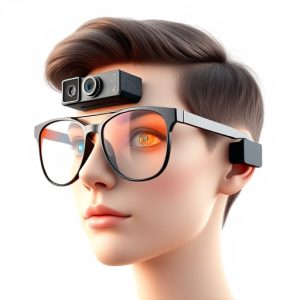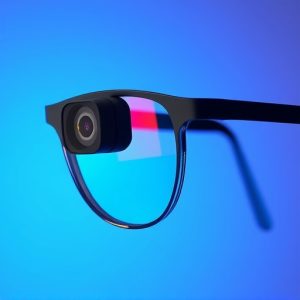Spy Glasses Uncovered: Exploring Camera-Equipped Eyewear and Its Implications
Glasses with cameras have evolved from specialized devices for covert surveillance to versatile con…….
Glasses with cameras have evolved from specialized devices for covert surveillance to versatile consumer electronics that serve practical and stylish purposes. They now support high-resolution recording for various uses such as security, real estate, and events, while also featuring clear privacy indicators. These smart glasses are on the cusp of revolutionizing our daily experiences with their augmented reality capabilities, potentially overlays digital data onto our field of vision. As technology advances, their utility and style will become even more integral to our lives, marking a significant shift in their significance. When choosing these devices, one must consider technical aspects like camera resolution, field of view, image stabilization, storage options, connectivity, battery life, megapixel count, audio functionality, and both legal and ethical implications of their use. It's crucial to navigate the balance between innovation and privacy rights, ensuring responsible use that respects individual space and adheres to local regulations.
Glasses have long been more than mere vision correctors; they’ve evolved into sophisticated tools that blend functionality with discretion. Today, we delve into the intriguing realm of spy glasses—frames equipped with cameras. This article unravels the covert capabilities and history of these versatile devices, examines their technical specifications, and addresses the pressing legal and ethical questions they raise when worn in public spaces. Join us as we explore how glasses with a camera built in are transforming surveillance, security, and personal documentation.
Unveiling the Secret World of Spy Glasses: A Closer Look at Glasses with a Camera Built In
Glasses with a camera built-in have transcended from the pages of spy novels and the silver screen into the realm of everyday technology. These sophisticated optical devices offer users the ability to capture high-resolution footage discreetly, blending the functionality of surveillance gear with the mundanity of eyewear. The integration of cameras within glasses not only serves as a covert tool for recording but also as an assistive technology that can enhance the visual experience for individuals with visual impairments. The miniaturization of camera components has allowed manufacturers to design glasses that maintain both a stylish and unobtrusive appearance while providing users with real-time video capabilities at their fingertips.
The utility of glasses with a camera built in is manifold, ranging from security purposes to professional applications such as real estate or event documentation. These devices are engineered with privacy in mind, often featuring LED indicators that alert observers when recording is active. The integration of this technology also opens up opportunities for augmented reality applications, where digital information can be overlaid onto the user’s view of the world. As the technology advances, the potential uses for these spy glasses continue to expand, offering a glimpse into a future where our everyday devices may become even more intertwined with our daily lives and interactions.
The Evolution and Functionality of Spy Glasses with Integrated Cameras
Over the years, spy glasses have evolved from being mere espionage tools to consumer electronics that offer enhanced functionality and convenience. Initially conceived for covert surveillance operations, these devices have transitioned into practical applications, where glasses with a camera built in serve as personal security aids, evidence documenters, and even everyday accessory for those who value both style and utility. The integration of cameras into eyewear has become more refined, with high-resolution imaging capabilities that can capture clear, detailed footage. These devices are designed with miniaturized lenses and image sensors, ensuring they blend seamlessly into the frame without compromising on quality or aesthetics.
The functionality of spy glasses with a camera built in has expanded significantly. They now offer features like real-time streaming to smartphones or cloud services, motion detection, and even voice commands, allowing users to capture moments at will without drawing attention. The integration of these features into everyday eyewear means that users can record their experiences, enhance personal safety by capturing incidents as they occur, or simply enjoy the ability to take a photo or video without needing a separate device. As technology advances, we can expect even greater improvements in quality and functionality, making spy glasses with a camera built in an increasingly common sight in our everyday lives.
Technical Specifications: Understanding the Capabilities of Glasses with a Camera Built In
When considering the acquisition of spy glasses, also known as smart glasses with a camera built in, it’s crucial to delve into their technical specifications to fully grasp their capabilities. These high-tech eyewear pieces are equipped with miniature cameras that can capture both still images and video footage with remarkable clarity. The resolution of the camera is a significant factor; higher resolutions like 1080p or 4K can ensure crisper, more detailed imagery that’s suitable for various purposes, from casual photography to covert surveillance operations.
Furthermore, the field of view and image stabilization are pivotal aspects to consider. A wider field of view allows users to capture more of the surroundings without having to move the camera as much. Image stabilization technology is equally important, as it compensates for hand-shake or movement during recording, resulting in smoother footage. Additionally, these glasses often come with built-in storage, and many can link via Wi-Fi or Bluetooth to your smartphone or other devices, enabling real-time streaming or transfer of media. Battery life is another key specification; long-lasting batteries ensure that the spy glasses can record for extended periods without needing a recharge. When evaluating these gadgets, it’s also advisable to examine the camera’s megapixel count, as this dictates the quality of still images you can capture, with higher megapixels generally resulting in more detailed photos. Prospective users should also look into the glasses’ audio capabilities, if they include a microphone, and whether they offer features like voice commands or noise cancellation for clearer sound recordings. By thoroughly understanding these technical specifications, consumers can make an informed decision that aligns with their intended use of spy glasses with a camera built in.
Legal and Ethical Considerations of Wearing Glasses with Hidden Cameras in Public Spaces
The advent of glasses with a camera built in has raised important questions regarding privacy and surveillance in public spaces. As these devices become more sophisticated and ubiquitous, it becomes imperative to address the legal and ethical implications they carry. Legally, the use of such glasses must adhere to local laws governing recording and surveillance, which vary across jurisdictions. In some regions, it may be permissible to record in public provided one’s own face is not visible, whereas in others, consent from individuals who might be filmed is required. The ethical dimension extends beyond mere legality; it encompasses the respect for personal boundaries and the potential misuse of such technology. Ethical considerations demand a thoughtful approach to the use of glasses with a camera built in, ensuring that they are not employed for invasive or covert purposes. Users must navigate these devices with a sense of responsibility, cognizant of the trust and privacy of others in public spaces. It is crucial for individuals to be aware of the societal norms and legal frameworks governing recording in public, as well as the potential consequences of violating them. As these wearable cameras become more integrated into everyday life, a clear set of guidelines and a broader societal dialogue will be necessary to balance innovation with respect for individual privacy.


